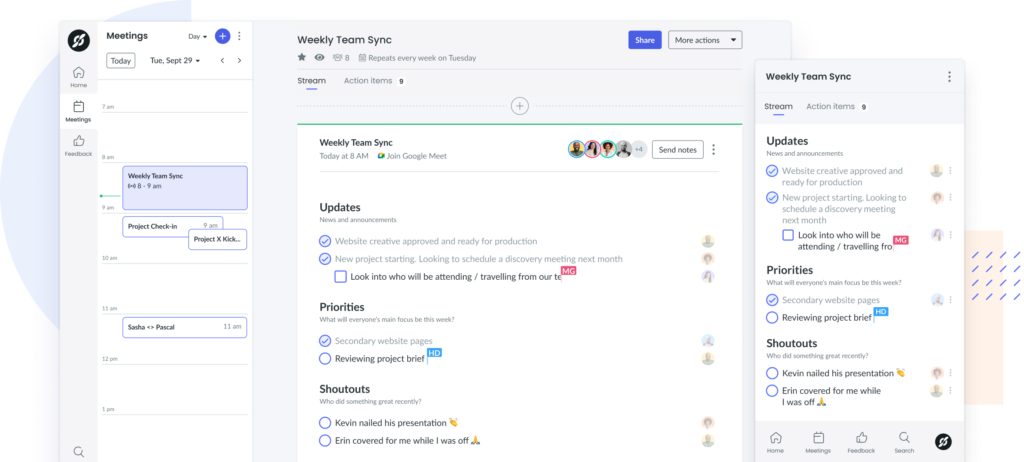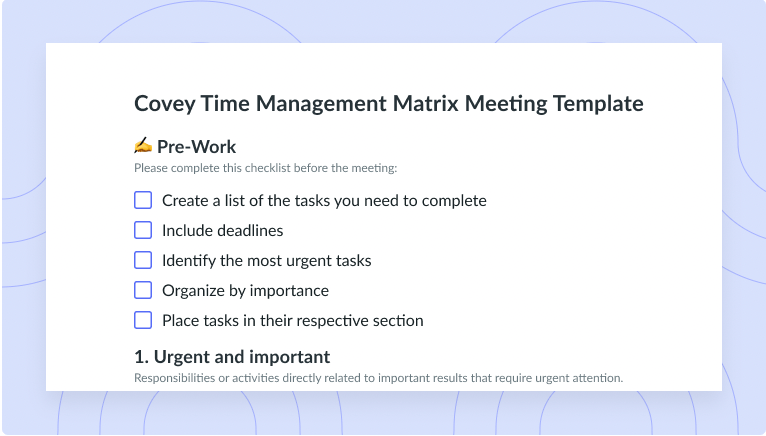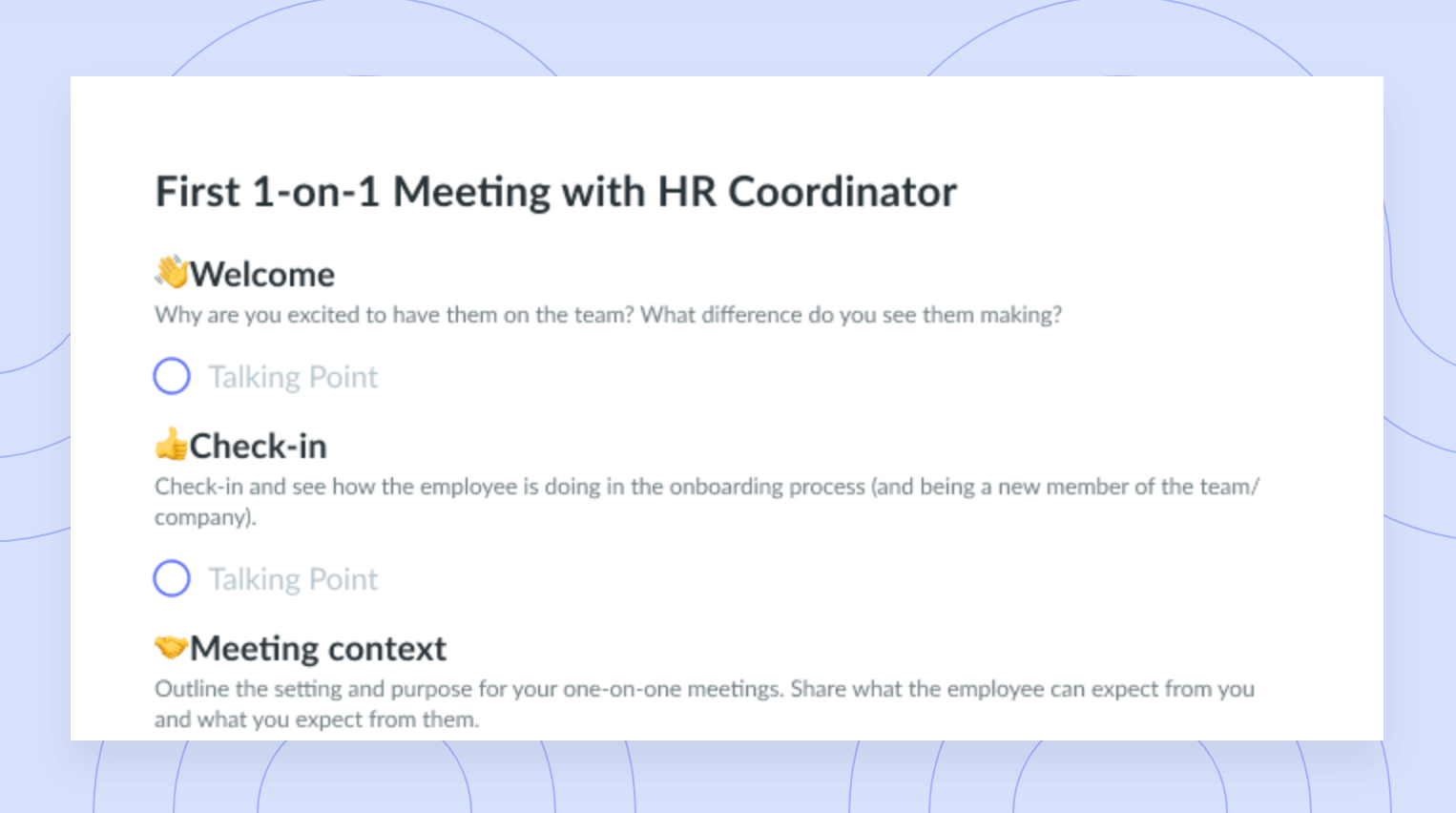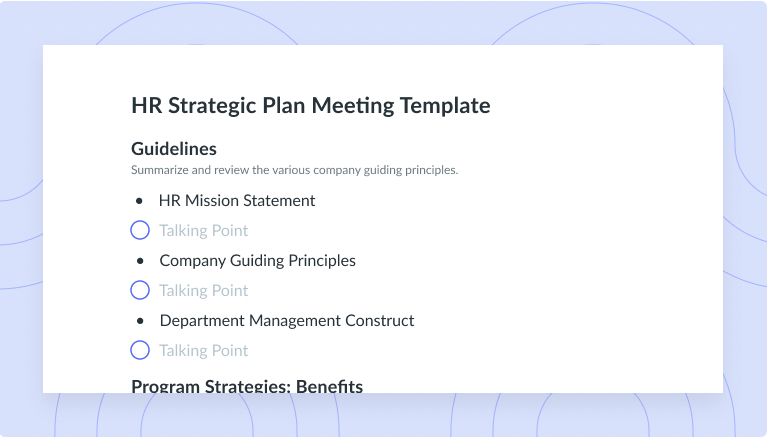The 13 Most Common Management Challenges and How to Overcome Them
Managers are presented with new sets of challenges every day. Here are 13 common management challenges and the solutions.
Managers oversee certain sides of the business that employees rarely see, but most managers were employees long before they were supervisors. So it’s understandable if you’re a manager feeling pretty challenged by some of your job’s demands. Even if you’ve been overseeing employees for ages, you might still face challenges that seem to lack obvious solutions. That’s why, here at Fellow, we’ve prepared the below guide to solving management challenges.
How to overcome management challenges
To ease the stress of your everyday management responsibilities, take a look at the below 13 challenges that managers often face and how you can overcome them.
- Communicating effectively
- Motivating your team
- Fostering teamwork
- Handling conflicts among team members
- Firing an employee
- Managing your time
- Hiring the right fit for your company
- Promoting the company’s mission
- Fostering a healthy company culture
- Preventing brain drain
- Mentoring employees
- Avoiding micromanagement
- Dealing with uncertainty
1 Communicating effectively
- Why is it challenging? A Harris Poll survey found that 69% of managers get uncomfortable before (or while) they communicate with employees. Since there’s often a divide between manager and employee duties, there may seem to be a line dividing managers from their employees in terms of the existing power dynamic. This can lead to employees feeling uncomfortable when presenting issues to managers or managers being unsure how to constructively give feedback to their employees.
- How to overcome it: A manager like yourself should communicate to your employees that they’re welcome to approach you with any matters that concern them. You should also build trust with employees by not sharing conversations from one employee with others. It’s also helpful to learn how your employees communicate. You should hold brief, casual conversations with employees to make sure discussions center around more than potentially intimidating matters such as performance.
2 Motivating your team
- Why is it challenging? We can all dream, but in reality, not every day at work will be an exciting one. For both you and your employees, tasks can become monotonous, and meetings can seem redundant if not done right. The result is that team members might question the need for certain processes.
- How to overcome it: Reevaluate your goals to check whether how you’re presenting them encourages your employees to think outside the box. Learn each employee’s individual goals and connect them with company resources that can help. For example, if a stockperson would one day like to become a cashier, allow them to periodically work with a cashier during a slow period in their shift. Help them see the value in their work and how it contributes to the company’s overall goals.
3 Fostering teamwork
- Why is it challenging? Many, if not most, tasks require productive collaboration among employees. However, team members’ work styles may vary. Even if these styles differ dramatically, managers like yourself remain responsible for creating work environments that merge these approaches and help members adapt to complete their projects.
- How to overcome it: Understanding employees’ work styles and how they are most productive individually can help you incorporate each person’s approach into a team-oriented plan for completing projects. Communicating the importance of working as a team can help employees understand the need for cooperation and motivate them to willingly participate in your efforts.
4 Handling conflicts among team members
- Why is it challenging? Just as disagreements may arise between friends or romantic partners, work relationships can have their own bouts of tension. If left to fester, these disagreements can destroy cohesion within teams and interfere with work productivity.
- How to overcome it: Organize a meeting with all conflicting parties and allow each person to respectfully convey their feelings while you mediate neutrally. Remind each person that their behaviors and reactions should promote a healthy work environment. Explain how their disagreement may be affecting productivity. Identify any underlying frustrations feeding the dispute, and recenter the conversation on making everyone happy.
5 Firing an employee
- Why is it challenging? Employee termination requires a conversation that is often undesirable. Whether due to underperformance, misconduct, or budgetary needs for layoffs, firing someone is never a pleasant experience.
- How to overcome it: Try to avoid firing an employee before doing so becomes truly necessary. Have a one-on-one meeting with the employee to discuss how their behavior or work isn’t meeting your performance standards. If the employee’s work performance is still dissatisfactory after a trial period, firing may be in order. When you fire the employee, clearly provide an honest explanation about why. If the employee is being laid off, share any applicable resources that can assist in their transition.
6 Managing your time
- Why is it challenging? In a managerial position, there are many tasks to juggle throughout the work day. Losing track of time in a meeting or underestimating how long a project will take can easily derail the remaining items on your agenda. Keeping your schedule on track and working through these tasks requires balance.
- How to overcome it: Time management can be as simple as keeping a calendar of tasks and events. Set daily and weekly goals, and detail when you hope to complete each task. Strategically planning your work days can give you an overview of where you need to focus your attention and help you allocate your time accordingly. You should also learn to delegate tasks among your employees. Identifying who can best handle tasks and training them to assume some of your responsibility allows you to distribute your time more evenly among other projects.

Pro tip
Use a meeting management tool like Fellow to better manage your time, assign action items, and organize meeting agendas for a productive use of time.

7 Hiring the right fit for your company
- Why is it challenging? Accepting applications for an open position can seem daunting. You might receive dozens of applications, each displaying an applicant’s highest accolades to earn a seat at your table. Amid this vast applicant pool, you’ll need to find the one applicant who most supports your company’s goals and aligns with its values.
- How to overcome it: When looking for a new hire to bring onto your team, first identify the core tenets of the open position. Explain what type of person your company wishes to have on its team. While considering an applicant’s qualifications, look beyond the experience on their resume at their work ethic and values. These considerations are just as important in shaping how the applicant will contribute to your company.
8 Promoting the company’s mission
- Why is it challenging? If you’re managing a fairly new company, your company’s mission might still be taking shape, making it tough to communicate. While encouraging mission ideas from your employees fosters open communication, it’s still better to keep employees working toward a clear cause. In doing so, you’ll center your company’s goals.
- How to overcome it: Remain focused on your company’s mission (even if you’re still developing it) and use it to guide work-related decisions. For example, let’s say your company places positive, effective communication high on its list of values. If you emphasize these values in your meetings and training materials, you can manage your employees in ways that align their work with your mission statement.
9 Fostering a healthy company culture
- Why is it challenging? Employees bring many different personalities and work styles to your company. Establishing a consistent company culture involves combining your company’s mission, values, and goals.
- How to overcome it: As you hire new employees, communicate your company’s mission and its core values. Establishing positive values will help your employees feel valued and foster open communication. If your company prides itself in prioritizing employee safety over productivity, consistently communicating this to your employees instills this value. Offer encouragement to your employees, and let them know that they are welcome to come to you for any learning opportunities.
10 Preventing brain drain
- Why is this challenging? Once team members no longer feel they can progress within your company, they may begin to question the need for their devoted efforts to your mission. As this valuable talent pool finds employment elsewhere, this phenomenon is known as brain drain. Squashing that notion before it becomes a staffing issue can often prove challenging without acting tactlessly.
- How to overcome it: Remember that employees have their own goals and aspirations alongside their commitment to working at your company. To address those goals, give your employees opportunities for professional development and prioritize a reasonable work-life balance. Paying competitive salaries can also help employees feel motivated to continue contributing to your company. Your employees should see their skills and worth developing while your company’s reach and revenue expands.
11 Mentoring employees
- Why is this challenging? Developing mentoring relationships with your employees requires learning about them on a deeper level. That means getting to know their individual goals and aspirations. However, when you have several employees to get to know and tons of work to do, it can be difficult not to prioritize the latter over the former.
- How to overcome it: Just as you create a daily and weekly schedule to manage your tasks, schedule time to meet with your employees to learn their career goals. Encourage employees to discuss their aspirations with you. If you still have trouble achieving these goals, remind yourself that mentoring others develops your leadership skills and helps you develop your own career goals.
12 Avoiding micromanagement
- Why is this challenging? Taking a hands-off approach to your employees’ work might make you appear like you’re not in control of your company’s productivity. Yes, the quality of your employees’ work can reflect your leadership, but helicopter-parenting your employees can inhibit their ability to work independently.
- How to overcome it: As you delegate tasks, clearly communicate your expectations for the results. Instead of constantly inquiring about or discussing your employees’ responsibilities, check in on their progress at most periodically. Let them approach you with any questions or concerns. Trust your leadership, the training you’ve given your employees, and your employees’ ability to use the skills they’ve developed.
13 Dealing with uncertainty
- Why is this challenging? Working in management often means deciding whether to take risks or play it safe. These decisions often come without a definite right or wrong answer. In other words, you might not know you’re making an incorrect decision until after you make it, and then, it’s too late to reverse course.
- How to overcome it: While a managerial position brings responsibilities in decision-making, it also brings a foundation of training, guidance, and expertise. Use these professional instincts to guide your decisions. Build certainty within yourself by examining your internal values such as integrity, courage, and purpose. Drawing from these values can help you remain calm, cool, and collected when working through difficult situations.
Continuing your leadership
Every day, managers are presented with new sets of challenges and long lists of responsibilities. With each of these challenges come solutions that support healthy working relationships, productivity, and individual growth. A great way to navigate these challenges alongside your team is to hold regular meetings, and as you do so, Fellow can help. With your action items clearly detailed and assigned – and your meeting notes clear and organized – keeping your team on the same page is that much easier.




![Crisis Management: How to Overcome a Business Crisis [+ Free Template]](https://fellow.app/wp-content/uploads/2022/06/Crisis-Management-2.jpg)























